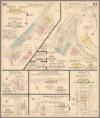 Railway Ramblers gazetteer Railway Ramblers gazetteer
See also the Railway Ramblers gazetteer -
Kirklees : LNWR
Batley - Birstall |
Batley Station (LNWR)
Opened 1848 to present
Batley Station : Bill McKelvie
The last Station Master at Batley was a man named
Mr Lamb who then went onto work at Dewsbury Wellington Road.
Batley had
at least five platforms two for the GNR route Bradford Wakefield.
Its
current operational two and a bay on the Leeds platform between it and
the Goods shed (which is now Angloco fire engines). |
 Layout
Plans : Keith Looker Layout
Plans : Keith Looker
Batley, Carlinghow, Birstal. |
 Birstall
Junction (31-03-06) : Allan Shaw Birstall
Junction (31-03-06) : Allan Shaw |
 Trackbed
(31-03-06) : Allan Shaw Trackbed
(31-03-06) : Allan Shaw |
 Bridge
(02-07-06) : Andrew Stopford Bridge
(02-07-06) : Andrew Stopford
Bridge over the Birstall branch at Batley. |
 Bridge
(20-08-06) : Andrew Stopford Bridge
(20-08-06) : Andrew Stopford
Bridge abutment on the Birstall Branch at Carlinghow
Hill. |
Carlinghow Station
Opened 01-04-1872. Closed 01-01-1917.
Carlinghow Station : Bill McKelvie
The location of Carlinghow station is
approximately 10 to 50 yards from the bridge support on Carlinghow Hill
(Birstall side of the bridge) and I recall seeing it many times as I
went to Batley General Hospital which is now a Nursing Home.
It was
accessible by the drive up to the Hospital
It was stone built and was probably on the left hand side of the track
as you would walk to Birstall.
It's length was not long at best 100 feet
complete with two ramps, very much a halt type station.
The locomotive that I used to see frequently on the line was usually one
with a tall chimney I can't recall whether it was a Jinty or an old
Claughton and tender nicknamed the 'Cody-Bob' possibly from the Mirfield
shed.
This pulled three or four 16 ton mineral wagons complete with
Guards Van possibly hauling coal for Birstall. It may have been on
duties permanently based at Batley and would also serve Dewsbury
Wellington Road Goods shed, and if it was going at the time, Shaw Cross
Colliery.
As I recall been offered a footplate ride at the time on a
similar tender engine at Dewsbury at the Goods side (on the Manchester
platform) which was operating from Batley. |
 Footpath
(20-08-06) : Andrew Stopford Footpath
(20-08-06) : Andrew Stopford
Kirklees Council has made a footpath here which
runs on the trackbed along the back of Wilton Park.
|
 Bridge
(26-11-07) : Paul Holroyd website - www.vintagecarriagestrust.org Bridge
(26-11-07) : Paul Holroyd website - www.vintagecarriagestrust.org
Bridge in Wilton Park, Batley. |
 Footbridge
(24-12-07) : Andrew Stopford Footbridge
(24-12-07) : Andrew Stopford
Footbridge over Birstall Branch at the station & yard
throat. Looking away from Birstall. |
 Footbridge
(24-12-07) : Andrew Stopford Footbridge
(24-12-07) : Andrew Stopford
Looking from the bridge towards the station & yard. |
 Footbridge
(24-12-07) : Andrew Stopford Footbridge
(24-12-07) : Andrew Stopford
Looking from the bridge towards Batley. |
Birstall Lower goods
Opened 30-09-1852. Closed 01-01-1917.
 Birstall
Lower goods yard : Tim Rylands Birstall
Lower goods yard : Tim Rylands |
 Birstall
Lower
goods yard (31-03-06) : Allan Shaw Birstall
Lower
goods yard (31-03-06) : Allan Shaw
Part
of one retaining wall of the station survives. |
 Birstall
Lower goods yard (20-08-06) : Andrew Stopford Birstall
Lower goods yard (20-08-06) : Andrew Stopford
Remnants of the yard/station at Birstall Smithies.
Platform on the left. |
 Birstall
Lower goods yard (20-08-06) : Andrew Stopford Birstall
Lower goods yard (20-08-06) : Andrew Stopford
You can see the platform edgings as they slope down at the end.
Note : Bill McKelvie
I can't ever recall the Station at Birstall but
it's location would have been at the Birstall Smithies Traffic lights
(A652 Bradford Rd/A62 Leeds Rd set).
I can recall the coaling stage which was at the rear of the Showboat pub
again stone built.
The water crane for the terminus was somewhere close to the pub and it's
base was there for quite a time after the railway had gone. |
